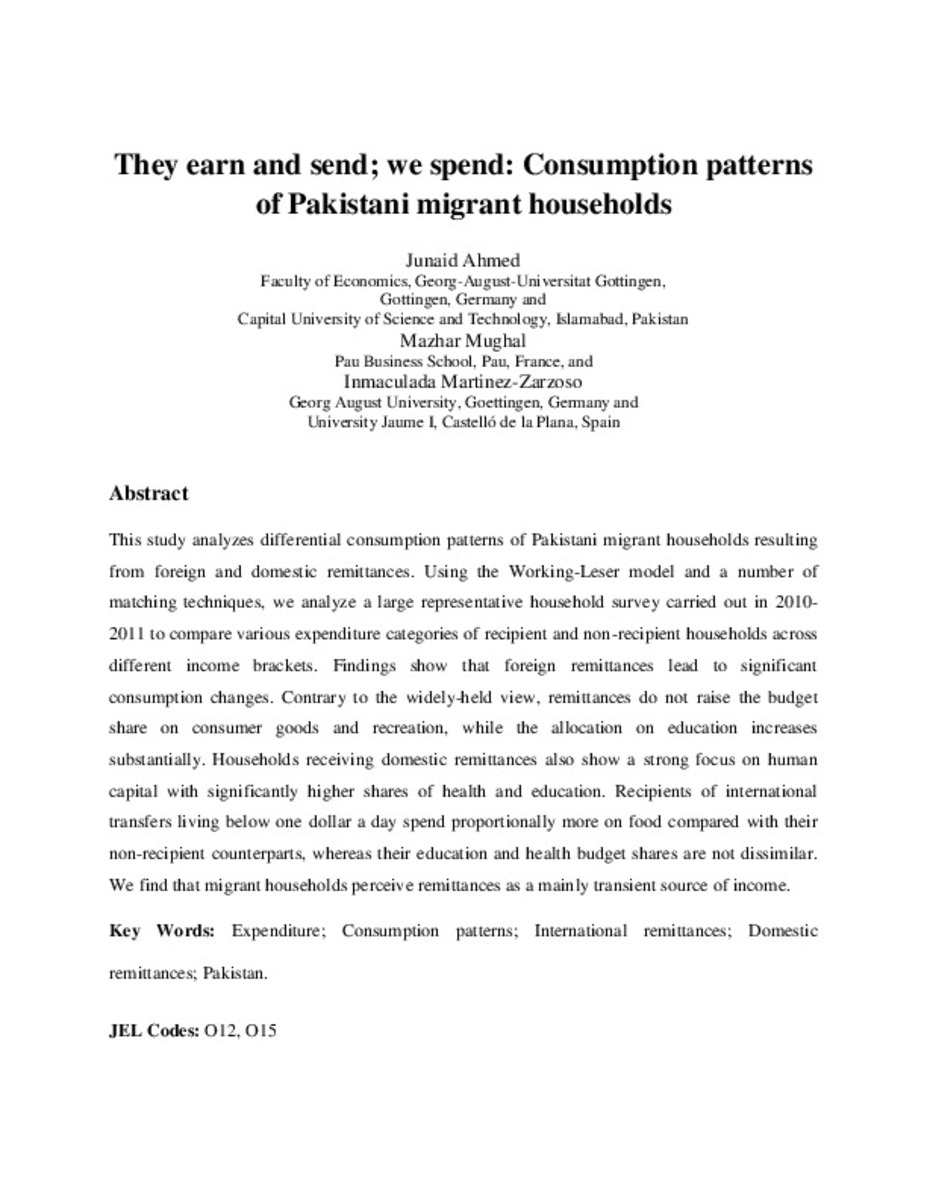Mostrar el registro sencillo del ítem
They earn and send; we spend: consumption patterns of Pakistani migrant households
| dc.contributor.author | Ahmed, Junaid | |
| dc.contributor.author | Mughal, Mazhar | |
| dc.contributor.author | Martinez-Zarzoso, Inmaculada | |
| dc.date.accessioned | 2018-11-15T13:01:29Z | |
| dc.date.available | 2018-11-15T13:01:29Z | |
| dc.date.issued | 2018 | |
| dc.identifier.citation | Junaid Ahmed, Mazhar Mughal, Inmaculada Martinez-Zarzoso, (2018) "They earn and send; we spend: consumption patterns of Pakistani migrant households", International Journal of Social Economics, Vol. 45 Issue: 7, pp.1092-1108, https://doi.org/10.1108/IJSE-01-2017-0029 | ca_CA |
| dc.identifier.uri | http://hdl.handle.net/10234/177508 | |
| dc.description.abstract | Purpose The purpose of this paper is to analyze differential consumption patterns of Pakistani migrant households resulting from foreign and domestic remittances. Design/methodology/approach Using the Working-Leser model and a number of matching techniques, the authors analyze a representative household survey carried out in 2010–2011 to compare various expenditure categories of recipient and non-recipient households across different income brackets. Findings Results show that foreign remittances lead to significant consumption changes. Contrary to the widely held view, remittances do not raise the budget share on consumer goods and recreation, while allocation on education increases substantially. Households receiving domestic remittances also reflect strong focus on human capital with significantly higher shares of health and education. Recipients of international transfers living below one dollar a day spend proportionally more on food compared with their non-recipient counterparts whereas their education and health budget shares are not dissimilar. Practical implications The positive effect of remittances on expenditures on human capital coupled with a lack of evidence suggesting an increase in the share of conspicuous spending resulting from remittances highlights the beneficial role that remittances play in a developing country. Originality/value Extant literature lacks consensus on whether migrant remittances should be treated as a temporary or permanent source of household income. In this study, the authors argue and empirically show that the two need not be mutually exclusive, and may co-exist depending on the nature of remittances and household characteristics. | ca_CA |
| dc.format.extent | 16 p. | ca_CA |
| dc.format.mimetype | application/pdf | ca_CA |
| dc.language.iso | eng | ca_CA |
| dc.publisher | Emerald | ca_CA |
| dc.rights | © Emerald Publishing Limited 2018. Licensed re-use rights only | ca_CA |
| dc.rights.uri | http://rightsstatements.org/vocab/InC/1.0/ | * |
| dc.subject | Pakistan | ca_CA |
| dc.subject | consumption patterns | ca_CA |
| dc.subject | expenditure | ca_CA |
| dc.subject | domestic remittances | ca_CA |
| dc.subject | international remittances | ca_CA |
| dc.title | They earn and send; we spend: consumption patterns of Pakistani migrant households | ca_CA |
| dc.type | info:eu-repo/semantics/article | ca_CA |
| dc.identifier.doi | https://doi.org/10.1108/IJSE-01-2017-0029 | |
| dc.rights.accessRights | info:eu-repo/semantics/openAccess | ca_CA |
| dc.relation.publisherVersion | https://www.emeraldinsight.com/doi/full/10.1108/IJSE-01-2017-0029 | ca_CA |
| dc.type.version | info:eu-repo/semantics/acceptedVersion | ca_CA |
Ficheros en el ítem
Este ítem aparece en la(s) siguiente(s) colección(ones)
-
ECO_Articles [693]







